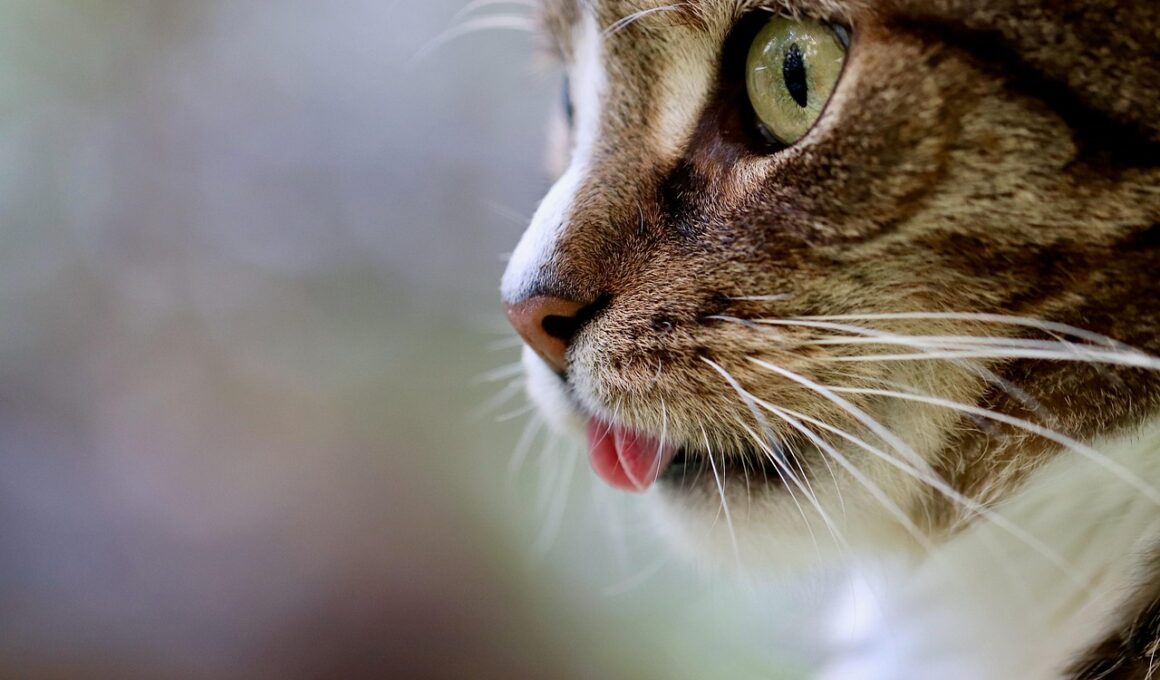Identifying Skin Allergies in Cats: What to Look For
Skin allergies in cats can be challenging for pet owners to recognize, as the symptoms may vary significantly. Cats may exhibit signs such as excessive scratching, biting, or licking of certain body areas. These behaviors can lead to more severe skin issues, and it is essential to address them promptly. Allergies are often caused by environmental factors, food ingredients, or parasites. Recognizing these allergies early can help provide your furry friend with relief and improve their quality of life. Look for distinct symptoms such as redness, swelling, or rashes, which may indicate a reaction to allergens. Keep in mind that allergies can develop at any age, rather than only in kittens or older cats. If you notice your cat exhibiting unusual behaviors, consult your veterinarian for further evaluation. They may suggest specific tests, like skin scrapings or allergy tests, to identify the cause of your cat’s discomfort. Ultimately, recognizing allergens will aid you in understanding your pet’s specific needs, leading to optimal care and overall health. Always prioritize communication with your vet to ensure proper treatment and response to your cat’s needs.
In addition to excessive scratching, other symptoms signal potential skin allergies in your cat. Check for fur loss, inflammation, or scabs on the skin. Spotting these issues early on can help you tackle allergens before they worsen. Allergies may worsen over time if left untreated, leading to persistent discomfort. A multifaceted approach toward identifying allergens is crucial, encompassing your cat’s environment, diet, and health. For instance, environmental allergens like pollen and mold can affect your pet. Routinely clean your home to minimize exposure to such irritants. A cat’s diet may also contribute to allergies. Common food ingredients clients must observe include grains, dairy, and fish. Switching to a specialized diet might provide relief for allergy-prone cats. Your vet may advise conducting an elimination diet trial, allowing you to observe any changes in your cat’s symptoms after removing potential allergenic foods. Always document your findings to share with your veterinarian, ensuring they have a comprehensive understanding of your cat’s condition. Proactive measures lead to a healthier and happier pet while improving your quality of life as a cat owner.
Recognizing Behavioral Changes
Behavioral changes can offer vital clues about your cat’s health, particularly regarding potential skin allergies. If your cat becomes increasingly irritable, withdrawn, or aggressive, it may be trying to express discomfort or pain caused by allergens. Pay close attention to normal behaviors that shift—like grooming more frequently or avoiding certain areas in your home. Cats are typically sensitive creatures, and they may react to external stressors beyond physical ailments. Understanding how your cat communicates through behavior can enhance your ability to respond to their needs. Regular interaction may help you gauge your cat’s emotional state, allowing you to identify any significant changes over time. Behavior might improve with flea prevention, allergy management, or dietary adjustments. Make a point of observing your cat in various situations to better highlight any emerging issues. This vigilance will provide beneficial information during vet visits and contribute to a faster assessment of your pet’s condition. Keeping a record of behavioral changes can prove invaluable, enabling you and your veterinarian to develop an appropriate treatment plan tailored to your specific cat’s needs.
Along with behavioral changes, specific grooming habits can signal skin allergies in cats. Excessive licking or scratching, especially in localized areas, can damage the skin and result in secondary infections. Furthermore, frequent grooming may lead to bald patches. Another sign to look out for is if your cat spends most of its time grooming itself along its abdomen, tail, or paws. This targeted grooming often results from an allergic reaction that causes localized irritation. When observing such behaviors, it’s essential to note any skin reactions, like blisters, redness, or crustiness. Consult your veterinarian if you suspect your cat suffers from skin allergies. They may recommend various treatments, ranging from topical medications and steroid therapies to changes in diet. Your vet can conduct tests to identify triggers, tailoring a personalized plan to alleviate your cat’s discomfort and improve its skin condition. Remember that time is of the essence; managing allergies effectively can lead to a calmer, more enjoyable life for both you and your feline friend. Prioritize your cat’s health by remaining vigilant and proactive in addressing potential sensitivities.
Environmental Factors
Environmental factors play a significant role in the development of skin allergies in cats. Dust mites, pollen, and mold are common allergens that may affect your cat’s skin health. To mitigate these risks, engage in regular cleaning routines to minimize allergens within your home. Consider using air purifiers to improve air quality and reduce allergens. If your cat spends time outdoors, monitor their exposure to common outdoor allergens like grasses and weeds during peak seasons. Bathing your cat and using hypoallergenic shampoos may help alleviate skin issues related to environmental allergens. Consult your vet for recommendations on safe and effective grooming products. Outdoor exposure can lead to fleas, which are another common source of allergic reactions. Ensure your cat is on an effective flea prevention program to avoid this irritating issue. By understanding the various environmental factors influencing your cat’s allergies, you can better protect them from common irritants. Make your home a safe haven for your feline friend. The more proactive you are in managing environmental factors, the healthier and more comfortable your cat will be.
Another crucial element in managing skin allergies in cats is understanding the role of parasites. Fleas, ticks, and mites can exacerbate skin sensitivities and lead to significant discomfort. Flea allergy dermatitis, for instance, occurs when a cat has an allergic reaction to flea saliva, resulting in intense itching and inflammation. This condition must be promptly addressed to avoid severe skin damage and potential infections. Regular flea control treatment acts as a key preventive measure to keep these parasites at bay. Ensure that you follow your vet’s recommendations for flea treatment and prevention tailored to your cat’s specific needs. Additionally, ticks can carry diseases that compromise your cat’s overall health, making prevention equally important. Regularly check your cat for signs of ticks, especially if they frequent wooded areas. Equally important is maintaining proper hygiene in your cat’s living environment, as dirty spaces can harbor mites and other allergens. Regularly cleaning bedding, toys, and litter boxes can help create a healthier atmosphere. Overall, understanding the relationships between parasites and allergies is crucial for safeguarding your cat’s well-being.
Taking Action and Seeking Help
When it comes to managing skin allergies in cats, timely action is essential. If your cat shows persistent symptoms that indicate potential skin allergies, do not delay in seeking veterinary assistance. Early intervention helps prevent more severe health complications and improves your cat’s quality of life. During your visit, your vet will consider your pet’s history, symptoms, and lifestyle to develop an appropriate diagnostic plan. Be open and prepared to discuss anything you have observed regarding your cat’s behavior or condition. This information will aid your veterinarian in determining the cause of the allergies and creating an effective treatment strategy. Options may range from medication and specialized diets to holistic approaches. Collaborate with your veterinarian throughout the entire process, and do not hesitate to ask questions. Your understanding of your cat’s condition is vital for effective management and long-term outcomes. You deserve peace of mind knowing that you are taking the necessary steps toward keeping your furry friend healthy and happy. Prioritizing your pet’s comfort will ultimately enhance the bond you share with them.
In summary, identifying skin allergies in cats requires keen observation and understanding of their behaviors and environment. Paying attention to specific signs such as excessive grooming, irritation, and behavioral changes can help you recognize potential allergens affecting your pet. Consulting your veterinarian plays a critical role in addressing the issue effectively. It is essential to work closely with your veterinary professional to diagnose any allergies accurately. Conducting tests and identifying triggers enables you to create a coherent management plan. Keep in mind that allergies can have a significant impact on your cat’s quality of life, so you must take them seriously. By aiding your cat in managing their allergies, you provide them with the best opportunity for a happy and healthy life. Additionally, maintaining a clean environment and identifying dietary sensitivities play essential roles in the management of allergies. Always consider environmental and dietary factors when evaluating your cat’s health. With diligent care and mindful attention, you can successfully navigate the challenges associated with skin allergies, improving your cat’s overall well-being. Your commitment to their health will foster a loving and understanding relationship for years to come.


